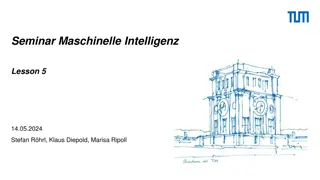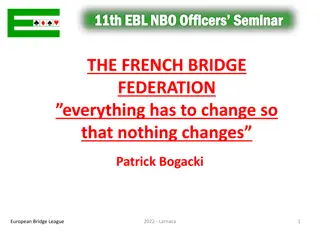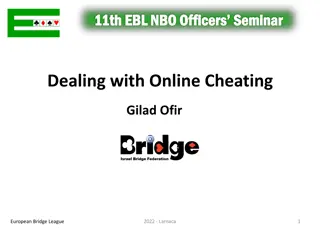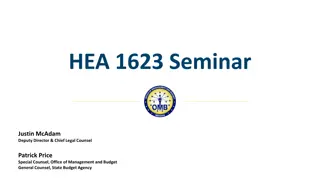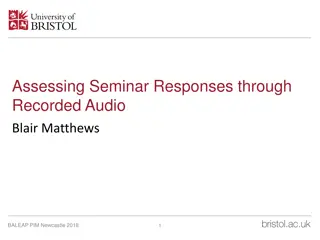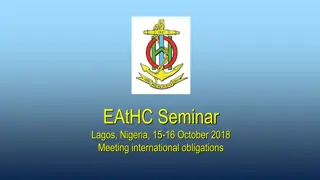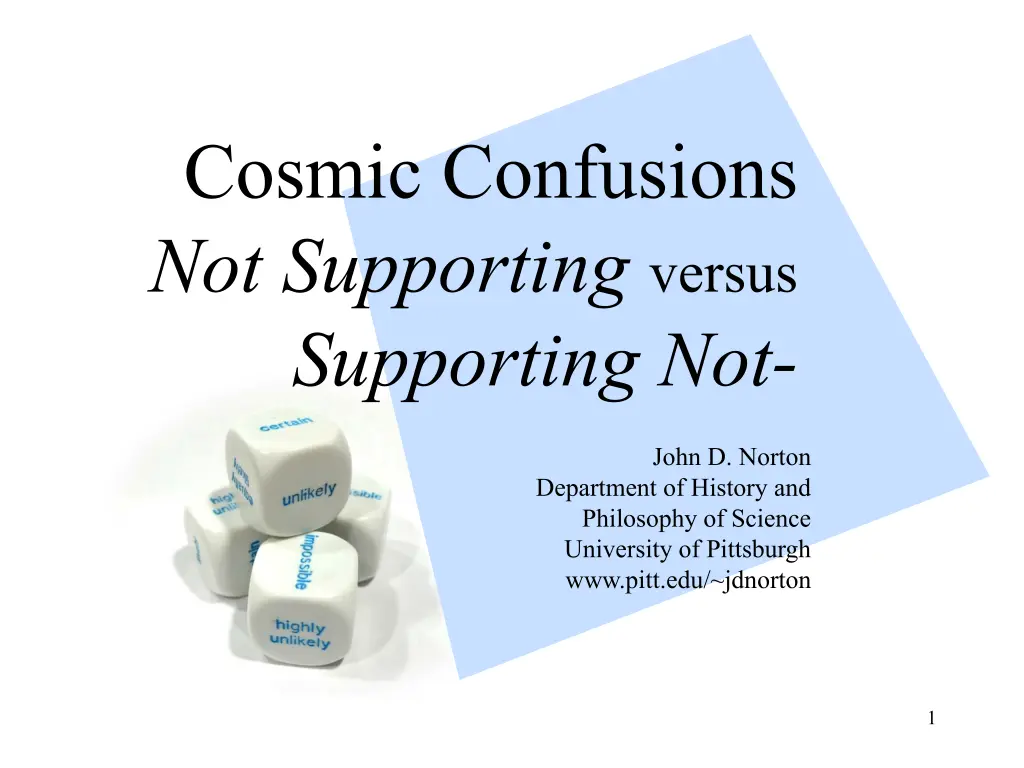
Understanding Evidential Neutrality and Disfavoring Support in Cosmology
Exploring the concept of completely neutral evidential support and the implications of disfavoring evidence in cosmological analysis. Delve into the principles of indifference, inductive logic fragments, and the challenges of assigning probabilities in parallel universes scenarios.
Download Presentation

Please find below an Image/Link to download the presentation.
The content on the website is provided AS IS for your information and personal use only. It may not be sold, licensed, or shared on other websites without obtaining consent from the author. If you encounter any issues during the download, it is possible that the publisher has removed the file from their server.
You are allowed to download the files provided on this website for personal or commercial use, subject to the condition that they are used lawfully. All files are the property of their respective owners.
The content on the website is provided AS IS for your information and personal use only. It may not be sold, licensed, or shared on other websites without obtaining consent from the author.
E N D
Presentation Transcript
Cosmic Confusions Not Supportingversus Supporting Not- John D. Norton Department of History and Philosophy of Science University of Pittsburgh www.pitt.edu/~jdnorton 1
This Talk Bayesian probabilistic analysis conflates neutrality of evidential support with disfavoring evidential support. Wrong formal tool for many problems in cosmology where neutral support is common. Fragments of inductive logics that tolerate neutral support displayed. Non-probabilistic state of completely neutral support. Artifacts are introduced by the use of the wrong inductive logic. Inductive disjunctive fallacy. Doomsday argument. 2
Principle of Indifference (evidential version) If the evidence does not distinguish among propositions, then they accrue the same inductive support. or withhold support (Ben Eva) maximum indifference over propositions State of completely neutral evidential support More options 3
Completely Neutral Evidential Support 4
Unconnected Parallel Universes: Completely Neutral Support Same laws, but constants undetermined. h = ? c = ? G = ? h = ? c = ? G = ? Background evidence is neutral on whether h lies in some tiny interval or outside it. h = ? c = ? G = ? h 5 1 2 3 5 0 4
Parallel Universes Born in a Singularity: Disfavoring Evidence Stochastic law assigns probabilities to values of constants. P(h1) = 0.01 P(h2) = 0.01 Background evidence strongly disfavors h lying in some tiny interval; and strongly favors h outside it. P(h3) = 0.01 very probable very very probable improbable h 6 1 2 3 5 0 4
How to Represent Completely Neutral Evidential Support 7
Probabilitiesfrom 1 to 0 span support to disfavor P(H|B) + P(not-H|B) = 1 Small. Strong Large. Strong favoring. Large. Strong favoring. Small. Strong disfavoring. disfavoring. No neutral probability value available for neutral support. 8
Underlying Conjecture of Bayesianism Logic of Logic of all evidence physical chances Fails 9
Completely Neutral Support [A|B] = support A accrues from B [ |B] = I proposition indifference ignorance any contingent I I I I I h 1 2 3 5 0 4 I I I Argued in some detail in John D. Norton, "Ignorance and Indifference." Philosophy of Science, 75 (2008), pp. 45-68. "Disbelief as the Dual of Belief." International Studies in the Philosophy of Science, 21(2007), pp. 231-252. 10
Justification I. Invariance under Redescription using the Principle of Indifference I I I I I Equal support for h in equal h-intervals. h 1 2 3 5 0 4 rescale h to h = f(h) I I I I I Equal support for h in equal h -intervals. h 1 2 3 5 0 4 [ h in [0,1] OR h in [1,2] | B] = [ h in [0,1] | B] = [ h in [1,2] | B] The principle of indifference does not lead to paradoxes. Paradoxes come from the assumption that evidential support must always be probabilistic. 11
Justification II. Invariance under Negation I I Equal (neutral) support for h in [0,1] and outside [0,1]. h 1 2 3 5 0 4 I I Equal (neutral) support for h in [0,2] and outside [0,2]. h 1 2 3 5 0 4 [ h in [0,1] OR h in [1,2] | B] = [ h in [0,1] | B] 12
Inductive Disjunctive Fallacy 13
Strongly disfavoring support Completely neutral support conflated with Disfavoring Neutral support a1 I I I prob = 0.01 a1 or a2 a1 or a2 or a3 a1 or a2or or a99 prob = 0.02 prob = 0.03 I prob = 0.99 Disjunction of very many neutrally supported outcomes a strongly supported outcome. is NOT 14
van Inwagen, Whyis There Anything At All? Proc. Arist. Soc., Supp., 70 (1996). pp.. 95-120. One way not to be. Infinitely many waysto be. Probability zero. As improbable as anything can be. Probability one. As probable as anything can be. 15
Our Large Civilization Ken Olum, Conflict between Anthropic Reasoning and Observations, Analysis, 64 (2004). pp. 1-8. Fewer ways we can be in small civilizations. Vastly more ways we can be in large civilizations. Anthropic reasoning predicts we are typical [it] predicts with great confidence that we belong to a large civilization. 16
Our Infinite Space Informal test of commitment to anthropic reasoning. Fewer ways we can be observers in a finite space. Infinitely more ways we can be observers in an infinite space. Hence our space is infinitely more likely to be geometrically infinite. 17
Inductive Logics that Tolerate Neutrality of Support 18
Discard Additivity, Keep Bayesian Dynamics If equal priors T1 entails E. T2 entails E. P(T1|B) = P(T2|B) Bayesian conditionalization. then equal posteriors P(T1|E&B) = P(T2|E&B) Postulate same rule in a new, non-additive inductive logic. If Conditionalizing from Complete Neutrality of T1 entails E. T2 entails E. [T1|B] = [T2|B] = I Support then [T1|E&B] = [T2|E&B] 19
Subjective Prior Problems 20
Pure Opinion Masquerading as Knowledge 1. Subjective Bayesian sets arbitrary priors on k1, k2, k3, Pure opinion. 2. Learn richest evidence = k135 or k136 3.Apply Bayes theorem 0.00095 P(k135|E&B) P(k135|B) = = 0.00005 P(k136|E&B) P(k136|B) P(k135|E&B) = 0.95 Endpoint of conditionalization dominated by pure opinion. P(k136|E&B) = 0.05 21
Pure Opinion Masquerading as Knowledge Solved Priors are completely neutral support over all [k1|B] = [k2|B] = [k3|B] = = [k135|B] = [k136|B] = = I values of ki. No normalization imposed. [k1|B] = [k1 or k2|B] = [k1 or k2 or k3|B] = = I Apply rule of conditionalization on completely neutral E = k135 or k136 [k135|B] = [k136|B] = I [k135|E&B] = [k136|E&B] Nothing in evidence discriminates between k135 or k136. support. Bayesian result of support for k135 over k136 is an artifact of the inability of a probability measure to represent neutrality of support. 22
The Doomsday Argument 23
Doomsday Argument (Bayesian analysis) Bayes theorem p(T|t&B) ~ p(t|T&B) . p(T|B) time = 0 Compute likelihood by assuming t is sampled uniformly from available times 0 to T. p(t|T&B) = 1/T we learn time t has passed For later: which is the right clock in which to sample uniformly? Physical time T? Number of people alive T ? Variation in likelihoods arise entirely from normalization. p(T|t&B) ~ 1/T Support for early doom Entire result depends on this normalization. time of doom T What support does t give to different times of doom T? Entire result is an artifact of the use of the wrong inductive logic. 24
Doomsday Argument (Barest non-probabilistic reanalysis.) Take evidence E is just that T>t. T1>t entails E. T2>t entails E. time = 0 E = T>t [T1|E&B] = [T2|E&B] [T1|B] = [T2|B] = I we learn time t has passed The evidence fails to discriminate between T1 and T2. Apply rule of conditionalization on completely neutral support. time of doom T What support does t give to different times of doom T? 25
Doomsday Argument (Bayesian analysis again) Consider only the posterior p(T|t&B) Require invariance of posterior under changes of units used to measure times T, t. Invariance under T =AT, t =At Days, weeks, years? Problem as posed presumes no time scale, no preferred unit of time. time = 0 Unique solution is the Jeffreys prior. we learn time t has passed p(T|t&B) = C(t)/T Infinite probability mass assigned to T>T*, no matter how large. Evidence supports latest possible time of doom. Disaster! This density cannot be normalized. time of doom T What support does t give to different times of doom T? 26
A Richer Non-Probabilistic Analysis Consider the non-probabilistic degree of support for T in the interval [T1,T2|t&B] Presume that there is a right clock-time in which to do the analysis, but we don t know which it is. So we may privilege no clock, which means we require invariance under change of clock: T = f(T), t = f(t), for strictly monotonic f. time = 0 we learn time t has passed [T1,T2|t&B] = [T3,T4|t&B] = I time of doom T for all T1,T2, T3,T4 What support does t give to different times of doom T? 27
Winding Up 28
This Talk Bayesian probabilistic analysis conflates neutrality of evidential support with disfavoring evidential support. Wrong formal tool for many problems in cosmology where neutral support is common. Fragments of inductive logics that tolerate neutral support displayed. Non-probabilistic state of completely neutral support. Artifacts are introduced by the use of the wrong inductive logic. Inductive disjunctive fallacy. Doomsday argument. 29
Finis 30
Appendices 31
Neutrality and Probabilistic Independence 32
Probabilistic independence vs. Neutrality of (total) support For a partition of all outcomes A1, A2, P(Ai|E&B) = P(Ai|B) all i [Ai|B] = I all contingent Ai For incremental measures of support* inc (Ai, E, B) = 0 Binary function Tertiary function Presupposes background probability measure. Presupposes NO background probability measure. * e.g. d(Ai, E, B) = P(Ai|E&B) - P(Ai|B) s(Ai, E, B) = P(Ai|E&B) - P(Ai|not-E&B) r(Ai, E, B) = log[ P(Ai|E&B)/P(Ai|B) ] etc. 33
Objective vs Subjective 34
Ignorance and Disbelief Neutrality and Disfavor or mad dog Bruno de Finetti Subjective Bayesianism degrees of belief Objective Bayesianism degrees of support In each evidential situation, Many conditional probability represents opinion + the import of evidence. Only one conditional probability correctly represents the import of evidence. Initial informationless priors? Pick any. They merely encode arbitrary opinion that will be wash out by evidence. Impossible. No probability measure captures complete neutrality. 35






